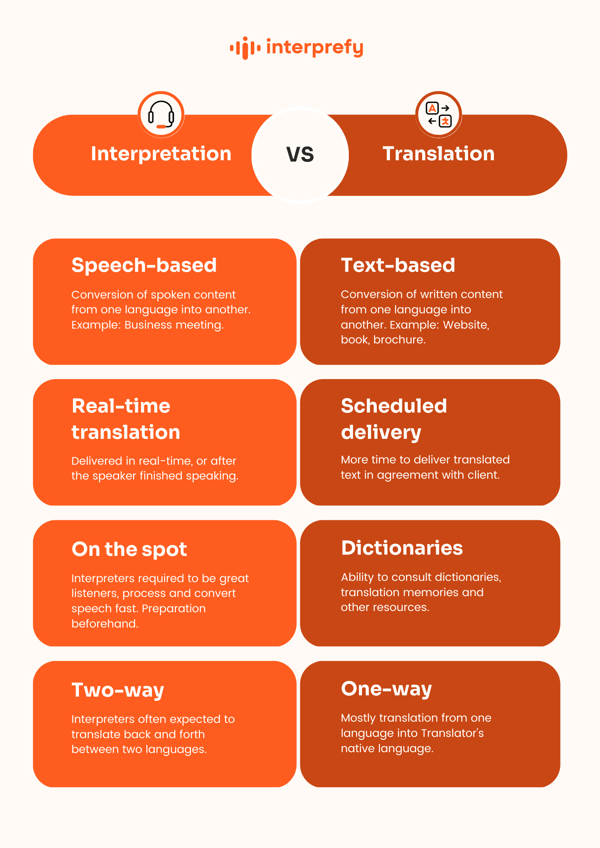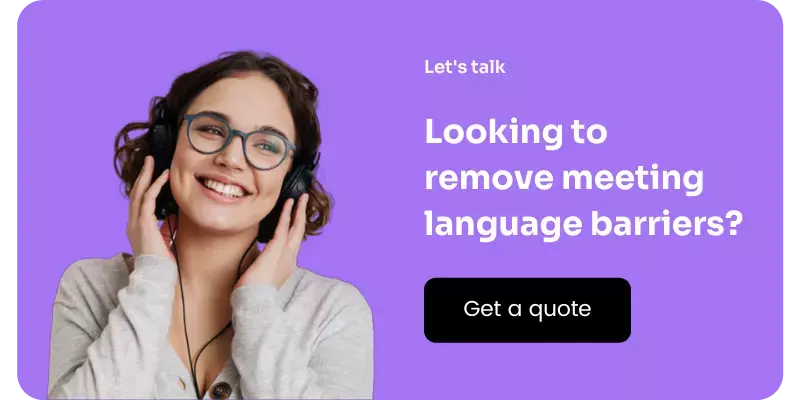Language is the basis of communication and the means through which we communicate ourselves to others. Communication might be difficult when we encounter someone who speaks a different language. This is where translation and interpretation come in useful.
Both translation and interpretation are methods that enable individuals to communicate across language obstacles. While the two names are sometimes used interchangeably, they have major differences.
In this post, we'll look at the distinctions between translation and interpretation.
In this article
- What is translation?
- What are the different types of translation?
- What does a translator do?
- What is interpretation?
- What are the different types of interpretation?
- What does an interpreter do?
- When do you need interpretation?
- The differences between interpretation and translation
What is translation?
The Oxford Dictionary defines translation as the process of converting something written or spoken from one language to another. The purpose of translation is to make content understandable to people who do not speak the original language.
The word translation stems from the Latin word "Translateo", which means "bringing across" or "carrying across".
What are the different types of translation?
There are different types of translation, including:
- literary translation
- legal translation
- medical translation
- technical translation
- and more.
Each type of translation requires specific knowledge and skills. Literary translation, for example, requires creativity and an understanding of the nuances of the language, while technical translation requires a solid knowledge of technical terminology.
Translation can either be achieved by a professional translator, Artificial Intelligence-powered machine translation technology, an individual with proficiency in two languages, or a mix of techniques.
Machine translation
Machine translation (MT) means that software, or artificial intelligence (AI), turns text in one language into another language. Unlike professional translations though, most machine translation engines don’t have the ability to consider context or tone because of their word-for-word nature.
What does a translator do?
The translator's job is to take the meaning of the text in the source language and convey it accurately in the target language.
Professional translators support individuals or organisations in making their written content available in a different language. For example, a book publisher might ask a translator to translate the contents of a book from one language (let’s say English) to another (Japanese).
Translator skills
It’s a professional translator's job to capture the content, style, tone, and form of the original text accurately and then render it into the target language in writing.
Translators need to be proficient in both the source and target languages, as well as be knowledgeable about the culture, context, and intended audience.
Translator tools
In the age of information technology, translators often utilize Artificial Intelligence tools as a way to produce more output in a shorter timeframe.
Professional translators can make the translation process easier by using machine translation tools and translation memory. Translation memories are similar to a database that has examples, sentences, and phrases in both the source language and the target language that are based on previous translations.
What is interpretation?
Interpretation is the process of translating spoken words between two languages. It is the responsibility of the interpreter to listen to what is being said in one language and accurately translate it into another.
What are the different types of interpretation?
There are several types of interpretation, including whispered, consecutive, and simultaneous interpretation. When the interpreter speaks at the same time as the speaker, and the message is communicated in real time, it is called simultaneous interpretation.
When the interpreter waits for the speaker to finish speaking before translating, this is known as consecutive interpretation. When a person needs interpretation, and the interpreter whispers the explanation to them, it is called whispered interpretation.
Recommended article
Types of interpretation you need to know
What does an interpreter do?
An interpreter is a person who makes communication between people who speak different languages possible. Interpreters are trained professionals with strong linguistic and cultural knowledge, who are able to interpret conversations or speeches in real-time.
When an interpreter is present in a conversation, or meeting, they will listen to the speaker's words and then convert them into the target language. The interpreter will strive to convey the meaning and tone of the original message as accurately as possible.
Interpreters work in a variety of settings, including conferences, webinars, legal proceedings, medical appointments, business meetings, and more.
The interpreter acts as a conduit between the parties, ensuring that the communication is as clear and accurate as possible.
Interpreter skills
To achieve this, they must have excellent language skills, including fluency in both languages. Interpreters must also be skilled in active listening, note-taking, and have the ability to convey subtle nuances in language and culture.
Especially in simultaneous interpretation, interpreters must be quick on their feet, possess a strong memory, and be proficient note-takers. Within seconds they understand, digest, and relay messages to audiences in another language in spoken or signed form.
Interpreter tools
Depending on the setting, interpreters use different tools to accomplish their tasks. While whispered interpretation is often done face-to-face, simultaneous interpretation relies heavily on technology. When interpreters work from a booth inside the conference venue, often sound booths, and extensive hardware, including an interpretation hard console are necessary.
In modern settings, interpreters utilize interpreting software to stream their rendition of the speech to participants on meeting platforms, mobile apps, or audio receivers.
Simultaneous interpretation services
Looking for live interpreters?
When do you need interpretation?
When speech in one language needs to be translated into speech in another, interpretation is extremely helpful. This may be done in order to reach a larger audience, communicate efficiently with commercial partners abroad, or participate in diplomatic gatherings.
The differences between translation and interpretation
Translation and interpretation are both vital processes that allow people to communicate across language barriers.
Understanding the differences between translation and interpretation is crucial, as it helps us appreciate the unique challenges that each process presents.
Whether you need a document translated or a speech interpreted, knowing the right process to use can make all the difference in ensuring effective communication.
Speech vs text
Translation predominantly deals with written language, while interpretation deals with spoken language.
Delivery time
Translation takes longer than interpretation. Interpreters are tasked to translate the message immediately, while translators usually have days or even weeks to deliver the translation.
Translation accuracy
For both processes, accuracy is critical. But interpreting requires slightly lower precision. Interpreters aim for perfection, but in practice, they have to make quick decisions. Interpreters often paraphrase or leave out parts of the speech.
Translators, on the other hand, can utilize their time to hunt for precise, particular words and synonyms.
Non-verbal communication
Because they have the opportunity to notice facial expressions, and voice tone, interpreters can alter the perception of speech in multicultural gatherings. Interpreters can understand jokes, metaphors, and tone and assess how these sentences might be perceived by the target audience.

The key differences between interpretation and translation
What does Interprefy offer?
A leader in simultaneous interpreting services, Interprefy supports organisations in removing language barriers during conferences, business meetings, town halls and more.
If you're looking to add simultaneous interpretation or multilingual closed captioning to an upcoming meeting or event, you've come to the right place. Thousands of organisations of all shapes and sizes have worked with us to eliminate meeting communication barriers.





 More download links
More download links



